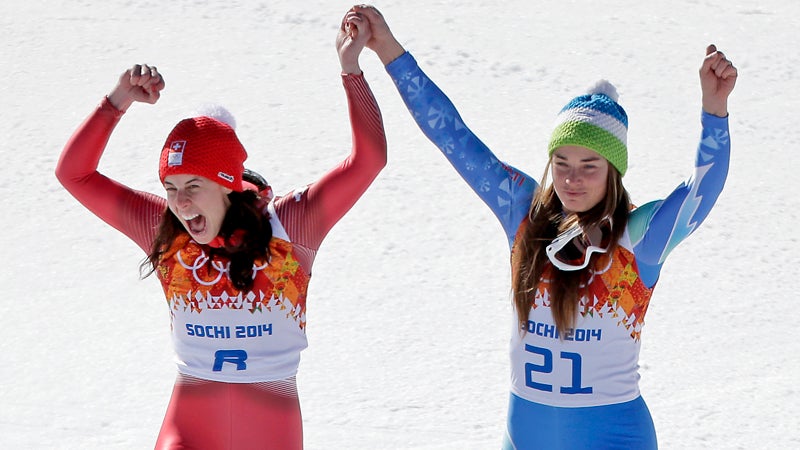Well, that was a little awkward.
In the women’s downhill ski race at the Sochi Olympics on Wednesday, Slovenia’s Tina Maze and Switzerland’s Dominique Gisin covered the 1.69-mile downhill course at the Rosa Khutor Alpine Center in the same time, down to the hundredth of a second—1:41.57.
It was the . And although the racers seemed to take it in stride—“I’m sure glad I get to share this gold with Tina,” says Gisin—the fact is, they didn’t actually tie.
“This is the Olympics, not a pee-wee league where everyone gets orange slices and participation awards.”
According to official International Ski Federation—or FIS—rules, times are measured and recorded to 1/10,000th of a second, but rounded to 1/100th. So why allow the tie? FIS Communications Manager Jenny Wiedeke : “When you start getting into such small numbers you cannot guarantee the integrity of that number.”
If I may, Jenny—bullshit.
This isn’t a situation where a tie is a regrettable result of some technological limitation. Since 1936, the official timekeepers of the Olympics have been Omega and Swiss Timing, both subsidiaries of Swatch. Peter Hürzeler, head of Omega’s sports timing division, told ���ϳԹ��� that Omega has been able to measure race times to 1/1,000th of a second since the ’70s.
Strangely, given these capabilities, few sports measure even to the thousandth of a second—at the Winter Games, only luge and speedskating go to three places right of the decimal point. (Luge officials .)
Ties seem to just retrench norms. After a gold medal in the 400-meter individual medley at the 1972 Olympics was decided on thousandths, swimming’s governing body declared that, henceforth, times would only be measured to the hundredth.
And don’t expect the FIS to re-examine its timing resolution. While this is the first Olympic gold-medal tie for alpine skiing, it’s happened repeatedly in World Cup races. Maze and Gisin have both been involved in ties at the World Cup level, too—in 2002 and 2009, respectively. Maze’s 2002 tie was, incredibly, a three-way split.
So who really won? Only the three-person timing team knows, and they’re not telling anyone. But while 1/100th of a second seems incredibly small, at downhill speeds that’s a significant interval.
For ski racing, Omega uses a photocell—an electronic system that starts when the racer trips a contact at the start gate and stops when the photocell at the finish detects the motion of the racer crossing the line.
The winners’ average speed was 56.6334mph, or 25.3174 meters per second. In a hundredth of a second, they would have travelled 25.32 centimeters, and 2.53 centimteres in a thousandth of a second. The Omega photocell can measure down to a 2.5-millimeter difference.
And even that’s not the limit of Omega’s capabilities. At the London Olympics, Omega called the Quantum Timer. It uses 16 separate clocks. The resolution? 1/1,000,000th of a second.
Hürzeler said Omega can only time to the rules, which each sport’s federation sets. But he’s philosophically okay with a tie. “I think it would be a scandal to go to the 1,000th or 10,000th to decide first and second,” he said. “You have someone who’s Olympic champion and then he’s not because the other guy was 1/1,000th of a second faster? It wouldn’t be correct.”
Opinions vary. Picabo Street, who won Olympic gold in Nagano by 1/100th of a second, . After all, this is the Olympics, the pinnacle of elite sport, not a pee-wee league where everyone gets orange slices and participation awards.
Ultimately, the issue isn’t with the timing capability—it’s the decision on how to apply it. The tie, said Hürzeler, “is a human result.” That’s true in more than one sense.


